It’s common practice among sellers to pack smaller boxes into a master carton, as this allows them to ship
multiple items while keeping costs low by achieving the smallest dimensional weight possible. Dimensional
weight is the amount of space a shipment occupies in relation to its actual weight. More on that later.
However, if you don’t know how to choose the correct carton size for your products or how to pack them
correctly, it quickly can lead to costly errors.
A good example of a costly packing error is additional shipping charges. A box that is unnecessarily large
due to excess packaging may be subject to an additional handling surcharge on top of other applicable fees
because the bulky box may require special handling or equipment in order to be loaded into a truck properly.
Plus, the box would take up more space that the carrier could use for other packages so they have to be
compensated for that, too.
Weight-related oversize charges may also apply if your package exceeds the maximum weight limit (usually over
70lbs). This is because the carrier cannot fill a trailer when heavier shipments prevent them from loading
more items when the truck’s max loading capacity is reached.
The rates for handling oversize packages vary by carrier. Let’s take FedEx’s additional charges as an
example. Additional oversize handling fees, ranging from $16 to $25 per package as of 2021, apply to oversize packages that
exceed 48″ on the longest side, 30″ on its second-longest side, or 105″ in length and girth combined. An
oversize charge of $105 also applies to packages that exceed 96″ in length or 130″ in length and girth
combined.
In addition, you could potentially be charged fees all along the way for those oversize packages – from
ocean/air shipping to ground freight to Amazon – each carrier could charge you an additional fee and all
that would really start adding up to some significant financial damage.
With Amazon, shipping unnecessarily large boxes can be even more punitive than with other vendors. According
to their strictly enforced box dimension policy, boxes that contain
several standard-size or oversized items must not exceed 25 inches on any side. A box may only go over the
25-inch limit if it contains oversize products that measure longer than 25 inches. Boxes that are
excessively large relative to the oversize units may lead to additional fees, restriction of shipping
privileges, or refusal at an Amazon FC.
So, unless you’re actually selling oversized products, it’s critical to stay off Amazon’s (and your
carrier’s) oversize categorization as much as possible to minimize shipping costs and avoid blocking of
future shipments.
In this post, I’ll walk you through everything you need to know about master cartons, including some tips for
optimizing your packaging to reduce shipping costs.
What is a Master Carton in Shipping?
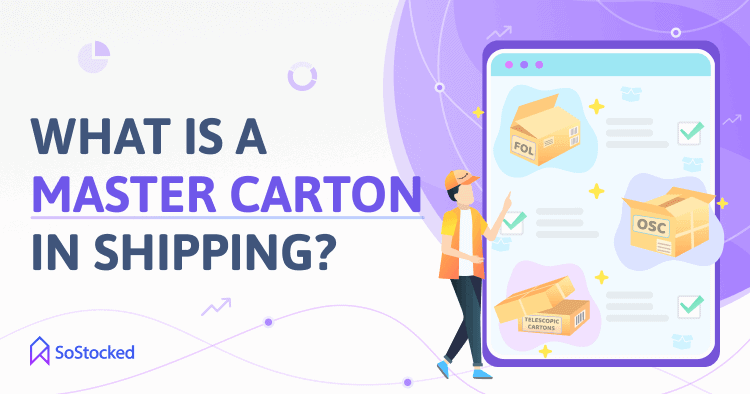
Also known as master case, a master carton is the durable outer packaging unit of inner packages. The best
way to describe it is like an exoskeleton that protects your smaller boxes (or products) from damage during
storage and transit.
3 Common Types of Master Cartons
- Regular Slotted Containers (RSC). This is one of the widely used types of master carton. The
space
between the inner flaps is in proportion to the ratio of width and length of the box. It can be utilized
to ship all product types and sizes, from lightweight to heavyweight. It’s also the most commonly used
carton for shipping products into Amazon.
- Telescopic cartons. This type of master carton has a separate top lid that fits over the separate
body of the box. It is suitable for storing food items that usually require ventilation.
- Fully overlapped cartons. This is a heavy-duty box for heavy-duty purposes. The cartons have
flaps of the same length and equal to the width of the box. The flaps fully cover each other when
folded, hence, the term “overlapped.” The overlapping flaps offer extra cushion to protect the contents
against rough handling, making it ideal for storing or shipping heavy items, such as antique pieces and
food products.
How Do Master Cartons Work?

Master cartons are designed to provide a large storage space and excellent protection against pressure and
damage by absorbing the rigors of handling and shipping environments, keeping the goods stored inside safe
and whole during transport.
Master cartons also make it easier for manufacturers to write important information on them with their smooth
surfaces. In logistics, it’s standard practice to mark the boxes with carton numbers, the quantity of units
inside each box, and hazard icons to help ensure shipments are handled properly.
You can also ask your supplier to include specific details on the master carton (e.g., product sizes, colors,
or expiration dates). And in addition to these specific requests, many suppliers will also include the
following information by default:
- Quantity
- Gross Weight
- Net Weight
- Supplier SKU
- Box measurements
- Box number, i.e., Box 45 of 100
When a master carton is broken down, Amazon will scan each unit inside the carton, add it into your
inventory, and distribute to multiple FCs. This also means that packing each item into an inner carton may
not be necessary when shipping to Amazon, allowing you to save some money on packaging. Inner cartons could
possibly be used for sending to 3PLs and then further broken down, but that would lead to extra fees.
How to Choose the Right Master Carton Size and Type
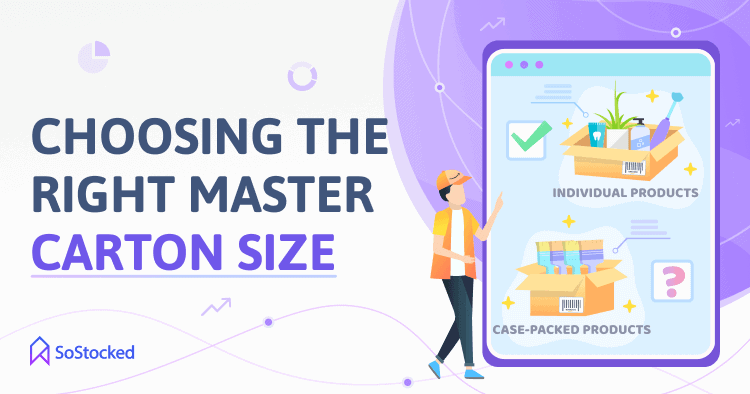
When choosing the right master carton for your inventory, consider the following:
FBA Packing Type: Individual vs. Case-Packed Products
When creating a shipping plan in your Seller Central account, you’ll be asked for the packing type that you
will be using: individual products or case-packed products. Making this selection will help you to figure
out what size master carton to use.
Select “individual products” if you’re planning to ship boxes that contain one or more products with varying
quantities or conditions (New, Renewed, or Used). Individually packed boxes can also contain more than 150
units per box.
Alternatively, choose “case-packed products” if your cartons contain identical items with matching SKUs in
the same condition. Once selected, enter the number of cases and units per case for each SKU in your
case-packed shipment.
Make sure that all boxes with the same product contain equal quantities of that product in each box. For
example, a case pack of 12 units must always contain 12 units. It is important to note that this case-packed
option only allows you to ship up to 150 units per case.
It’s also crucial to follow Amazon’s FBA products labeling requirements and packaging
requirements to avoid issues in receiving your inventory. For instance, case-packed products must
not have any scannable barcode on the case itself. Only the individual items inside the case should have
scannable barcodes. Failure to comply might result in refusal, return, or disposal of inventory. Additional
charges for extra preparation or for non-compliance at the fulfilment center might also apply.
Note: Case packs are different from multi-packs. Case packs are intended to be broken down and the
units sold individually. In contrast, multi-packs are sold as sets or bundles (e.g., a shampoo and
conditioner set). A case pack may be sold as a multi-pack, but it must be packaged according to the
requirements for products sold as a set. Check out Amazon’s Packaging and Prep Requirements for more information.
Restock Limits and Sales Velocity
Your restock limits and sales velocity also determine how many units you can pack and send to Amazon. If you
send in large amounts of slow-movers, let's say cartons containing no less than 3 months of stock, this is a
bad idea. Cartons that are packed with too many weeks’ or months’ worth of slow-moving inventory will make
it difficult for you to improve your sell-through and can be harmful to your restock limits and Inventory Performance Index (IPI) score.
So, your restock limit and sales velocity are also two important factors to keep in mind when planning your
carton sizes. Units per carton as it pertains to days of stock need to be considered with slow-movers.
Master Carton Sizing and FBA Box Limit per Delivery
Figuring out the right master carton size for your shipment can be a tough balancing act. There’s always the
possibility of miscalculating things, so careful planning is extremely important.
For instance, using a master carton that’s excessively large relative to the size of your packages can easily
push you into oversize categories with major carriers like FedEx (dimensions with a girth of more than 130
inches) and UPS (package length and girth exceeds 165 inches). On the other hand, using master cartons that
are too small may result in you having to create more shipments than necessary.
While you’ll have more cartons this way, it will increase your handling fees in the form of per carton fees.
It could also increase your overall shipping cost as some freight forwarders (FFs) are now imposing a carton
weight minimum. For example, if your FF is applying a 12kg per carton minimum, anything below that would
still be charged 12kg per carton.
This new cost structure was likely put into place so that package handlers aren’t handling more packages than
necessary. They would rather load and unload 200 slightly larger cartons in and out of warehouses/delivery
vehicles than 300 small cartons, for example. These imposed minimums help to encourage exporters to use more
efficient packaging methods (more on that later).
In addition, Amazon also has a limit on the total number of cartons per shipment. Exceeding this limit may
result in refusal of inventory at FBA.
-
For truck deliveries, a single Less than Truckload (LTL) shipment cannot exceed 5,000 boxes. If you want
to ship more than that, you must create a second shipment.
- For Small Parcel Deliveries (SPDs), there’s a 200-box limit per shipment for Amazon-partnered carriers
and 500-box limit per shipment for non-partnered carriers.
Make the most of your LTL or SPDs by increasing the carton size enough to both increase the number of units
per carton and reduce the number of cartons needed to ship all of your inventory. Having more units per
carton simply means less cartons, which means reduced shipping and handling costs.
Pallet Size
As a general rule, it’s best to pick a master carton size that’s planned around fitting on a standard pallet.
When choosing the right pallet size, consider the following Amazon pallet requirements:
Pallet Type
The standard pallet that sellers use for their Amazon shipments is a 40″ x 48″, 4-way access wooden pallet
(allows a forklift to get under a pallet on all 4 sides). But if a single, large unit cannot fit on a 40 x
48 inches pallet without overhanging the edges, you can use a pallet size and type that’s suitable for the
unit.
Pallet Weight
The total weight of your pallet must not exceed 1,500lbs (680kgs). To ensure the most efficient
unloading, receipt, and storage of your inventory, each box on the pallet must not exceed the standard
weight limit of 50lbs (22.6kg), unless the box contains a single oversize unit that weighs more than
50lbs.
Pallet Height
Pallet height varies depending on whether you’re using a:
- Single pallet or non-stackable pallet. A pallet may be deemed non-stackable if the item(s) cannot
be stacked due to its odd shape (e.g., furniture) or if it’s marked with “Do Not Stack” instructions.
Single pallets shipped with an Amazon-partnered carrier must not be higher than 72 inches. Amazon
will likely reject anything over this dimension. It is important to note that you will have to factor
the height of the pallet materials into this calculation which is approximately 6 inches. So,
given this, you have only 66 inches of carton height to stack.
To improve in-transit capacity efficiency (maximizing height capacity within the semi-trailer during
shipping), a single pallet can be stacked up to 98 inches high but must conform to the clampable
instructions found in Amazon’s Floor Loading Policy, which allows for the
pallets to be split into two units when received.
- Double-stacked or stackable pallets. This refers to a pair or groups of pallets that are stacked
for shipment and storage. Amazon accepts double-stacked pallets, but they cannot exceed 100 inches
total in height (50 inches per pallet stack). A pallet with a pack height no taller than 50
inches allows you to allocate 44 inches for the boxes and 6 inches for the pallet materials, the same as
with non-stackable pallets. This is space efficient and maximizes trailer space for standard
semi-trailer height.
Clearances Between Pallets and Other Elements
The overall height of your pallets must allow 6 inches of clearance from the top of the stack to the roof of
your trailer or container. Also, allow for at least 3 inches between pallets and container walls while in
transit by using:
- Air bags to ensure stability
- or a safety net or non-metal straps to prevent the boxes on the pallet from shifting or falling
Lastly, allow for at least 8 inches of clearance from the last row of pallets to container doors to properly
engage a dock leveler, a piece of equipment used to bridge the height gap between the semi-trailer and
loading dock floor.
Ensuring there’s proper space inside and around the pallet will help forklift operators or package handlers
work faster and more safely. When they have proper operating space, they can easily load or unload the
pallets from one location to another.
While too much clearance between your pallets and the trailer roof, walls, and doors won’t necessarily
slow things down, it will likely waste a lot of space.
Not accounting for pallet height and clearances can also be disastrous (and expensive). Let’s say you’re
shipping cartons that are 24″ high each on a non-stackable 72” pallet. In that case, you would only be able
to stack two cartons (48″ in height total plus 6” of pallet material for 54” total height), leaving you with
18″ of unused space (72” – 54”) on your single pallet. That is significantly less space efficient.
However, if you downsize your cartons from 24” to 16”, you could stack it 4 layers or 64″ high, leaving you
with only 2″ left of usable height, which is much more space efficient.
If you stack it too high, as some have done by not accounting for the 6″ of wooden pallet height clearance,
and build it up with 72″ of actual box height, all of those pallets would have to be unpalletized and
repalletized to actually be able to fit in the trailer or shelving system of your 3PL warehouse, costing you
palletization fees. They could also be rejected by Amazon.
Get advice from your 3PL on how best for optimized storage and the most streamlined, efficient delivery to
Amazon.
Note: For non-partnered carrier shipments that cannot be shipped on pallets and need to be
floor-loaded, see Amazon’s Floor
Loading Policy.
Cardboard Styles
Master cartons are typically made up of pieces of corrugated cardboard (shaped into alternate ridges or
series of waves, aka flutes) and linerboards (smooth outer facing material of the box). It is the cardboard
style and size of the flute that usually determine the strength of the box.
Understanding this part is crucial because some products require a certain cardboard style or flute size to
ensure maximum protection against pressure and puncture during storage or shipping. Read on to better
understand the basic qualities of corrugated master cartons.
4 Cardboard Styles
Single Face
A single face board only has two layers–a linerboard and a corrugated cardboard.
Because it’s lighter (or thinner) than other cardboard types, it’s often used as an added cushioning inside
larger boxes.
Single Wall or 3-Layer Cardboard
This board style is the most common type of corrugated cardboard.
It consists of two linerboards and a middle layer of corrugated medium. It’s ideal for transporting items
weighing less than 50lbs over relatively short distances. For longer-distance shipping, consider using 5- or
7-layer cardboard to ensure your packages stay in good shape during extra long transit times.
Double Wall or 5-Layer Cardboard
This board has three linerboards and two layers of corrugated
medium, making it highly durable and perfect for packages weighing 60lbs to 160lbs.
Triple Wall or 7-Layer Cardboard
This carton is strong and durable enough to be utilized in place
of wooden crates. It is made up of three layers of corrugated cardboard and four layers of linerboards,
making it the best choice for shipping extremely fragile or heavier items that require special handling,
such as glass or construction materials.
Pro tip: Often in the Amazon space, people talk about 5-layer or 7-layer and many sellers have
found that 5-layer wasn't even strong enough for the wear and tear during shipping these days with the
sloppy, rushed handling and also increasing number of units so many have advised using 7-layer
cardboard, especially when increasing their units per carton due to shifting and added weight strain.
Flute Sizes
The term “flute” refers to the corrugated element of a carton. It is used to strengthen the linerboards that
are used in shipping boxes.
There are different sizes of flutes, and they are designated by the letters A, B, C, E, or F. The letter
designation relates to the order in which the flutes were invented, not the relative sizes of the corrugated
boxes.
A Flute (¼” flute thickness)
Considered as the thickest flute, A-flute corrugated cardboard offers
excellent stiffness
qualities, crush resistance, and stacking strength. It also provides great cushioning, making it ideal for
packing fragile items.
B Flute (⅛” flute thickness)
This type provides excellent resistance against crushing pressure and
puncture. They are often used as packaging for canned goods, glass-to-glass packs, and beverage trays. It’s
also the preferred choice for inner packaging, i.e., pads, dividers, or partitions. Amazon requires
standard boxes to have a B-flute board.
C Flute (3/16” flute thickness)
C-flute cartons have great crush resistance and a smooth flat
surface for decent printing quality, especially for display packaging. They are most commonly used for
regular slotted container boxes, making C-flute cardboard perfect for storing food items, books, toys, among
other types of products. Approximately 80% of corrugated boxes are made of C-flute board.
E Flute (1/16” flute thickness)
This carton has a thin construction, which makes it easy to fold,
and thus takes up less storage space. The slim profile also gives the board a smoother printable surface
than C-flute cartons. In fact, the single-face E flute sheets usually go well with litho-laminated boxes, in
which paper is laminated on the board where high print quality and presentation is crucial. And although
slim, the 1/16” thick corrugated medium is enough to offer good crush resistance. That’s why it’s commonly
used for pizza boxes, shoe boxes, displays, and consumer goods boxes.
F Flute (1/32” flute thickness)
F-flute cartons have an extra-thin construction that allows for
stiffer boxes with less fiber content. With less fiber, there’s also less solid waste going into the
landfills. F-flute cardboard is often used as a fast-food clamshell container and retail packaging for
jewelry, cosmetics, and footwear.
Overall, larger flute sizes deliver greater stacking strength and cushioning, making them perfect shipping
boxes. Smaller flute sizes are typically designed to provide excellent structural strength and printing
capabilities for retail packaging.
Box Weight and Strength Requirements
Amazon requires standard boxes to score a minimum of 200lbs on the bursting strength test (the face of the
box can withstand up to 200lbs of force) and 32 Edge-Crush Test (ECT) or stacking strength test.
ECT is a method for measuring how much force a corrugated box can withstand on its edges without crushing or
before deformation takes place. A box’s ECT strength is measured by compressing a small part of the board
between two pressure plates. Pressure is applied until a peak load (the max amount of force the board can
withstand) is established.
ECT is measured in pounds per lineal inch of load bearing edge (lb/in), but typically expressed as an ECT
rating (e.g., 32 ECT). Scoring 32 on ECT means that the corrugated box can withstand up to 32 lbs per inch
vertical compression, i.e., crush resistance strength when sandwiched between upper and lower boxes. A 32
ECT corrugated box can also hold up to 65lbs of weight.
Certain box weight restrictions also apply to prevent sellers from
sending overweight packages. Make sure that your cartons meet the following weight requirements before
shipping to FBA:
- If using case-packed products, you may only send up to 150 units per master carton.
- Boxes must not exceed the standard weight limit of 50lbs (22.6kg), unless they contain one single item
that exceeds that limit.
- For a single item that exceeds 50lbs, affix a label that clearly shows “Team Lift” on the top and
sides of the box.
- For a single item that exceeds 100lbs (45.3kg), affix a label that clearly shows “Mechanical Lift”
on the top and sides of the box.
- Boxes that contain jewelry or watches must not exceed 40lbs (22.2kg).
Aside from Amazon, trucking carriers have also set their own box weight and strength requirements to ensure
you select the correct carton type based on the weight of your products. These requirements may vary by
service provider, however, so check with your carrier for more information.
To give you an idea, here are some details within the UPS packing guidelines:
| UPS |
Box Type |
| 30lbs |
32 ETC Single Wall |
| 40lbs |
200lb Bursting Strength Single Wall
|
| 50lbs |
44 ECT Single Wall
|
| 60lbs |
48 ECT Double Wall
|
| 80lbs |
51 ECT Double Wall
|
Master Carton Calculator
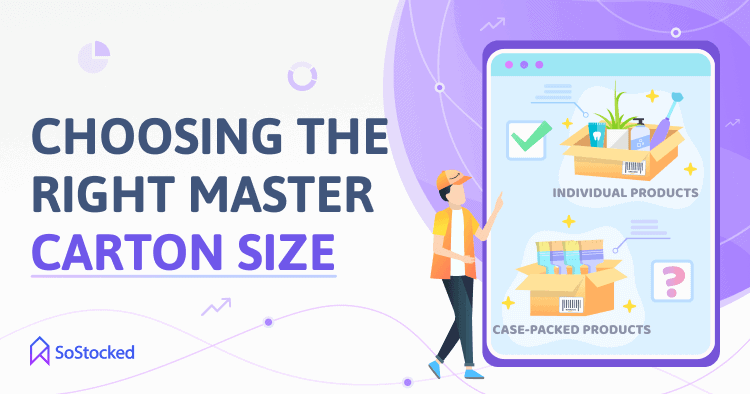
Master cartons come in several sizes to suit the needs of the buyer. Therefore, the quantity mainly depends
on your requirements, such as your budget, restock limits, max weight limit per carton, and Amazon box limit
per shipment.
Manufacturers also design these cartons with freight consolidation and carrier packaging requirements in mind
so that packages can be shipped and delivered on time.
Use a master carton calculator to configure your master carton properly. We're currently building a tool that
will not only help you calculate how many cartons fit in a master case but also factor in common packaging
fees so you can plan your shipping more thoroughly. These fees include freight forwarder minimum weight
fees, over and under-size fees, carton labeling, carton pull fees, and warehouse labor costs. We'll let you
know once the tool is ready to use, so subscribe
to get notified!
How Much Will It Cost to Ship Each Master Carton?
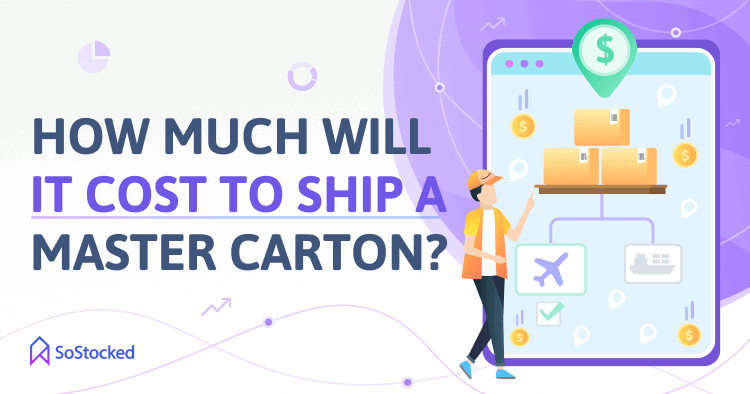
Shipping rates vary depending on several factors – package dimensions, weight, shipment origin and
destination, insurance, warehouse fees, and so on. Once these factors are factored in, your
carrier will be able to provide you with a quote.
Package Dimensions
As mentioned earlier, major carriers now use the so-called dimensional weight (DIM) pricing
technique to calculate shipping fees.
Dimensional weight, aka volumetric weight, is determined by multiplying the length, width, and height of your
carton, then dividing by a standard DIM factor or DIM divisor. A DIM divisor is a number set by carriers
that represents the volume of a package allowed per unit of weight. It’s basically the number by which you
multiply the package dimensions to find the weight.
How to Calculate DIM divisors?
There are two different ways to determine DIM divisors. One is calculated using inches/pounds and the other,
using centimeters/kilograms.
Finding a DIM divisor using in/lb
If each cubic foot (12” x 12” x 12”) has a min weight allowance of 12.5lbs, the DIM divisor would be:
(L” x W” x H”) ÷ Minimum Weight Allowance =
DIM Divisor in/lb
- or -
(12” x 12” x 12”) ÷ 12.5lbs =
138.24 cubic inches per lb
Finding a DIM divisor using cm/kg
If each cubic meter (100cm x 100cm x 100cm) has a min weight allowance of 200kg, the DIM divisor would be:
(L cm x W cm x H cm) ÷ Minimum Weight Allowance =
DIM Divisor cm/kg
- or -
(100cm x 100cm x 100cm)
÷ 200kgs =
5000 cm³/kg
How to Calculate DIM Weight?
UPS, USPS, FedEx, and other major carriers calculate shipping rates based on whichever is greater between the
actual weight of the package (refers to how much your cargo weighs, including its pallets and packaging) and
its DIM weight. Whichever is higher becomes the billable or chargeable weight.
DIM Weight Sample Calculation in Inches
Let’s assume that you have the following variables:
- L (in) = 12.75
- W (in) = 6.34
- H (in) = 13.5
- DIM Divisor: 139 (commonly used by FedEx and UPS for domestic and international shipments)
12.7 x 6.34 x 13.5 ÷ 139 =
7.85 lbs DIM weight
If the actual weight of the shipment is less than 7.85 lbs, the carrier will charge for the dimensional
weight of 7.85 lbs since it is the greater number.
If the actual weight of the package is more than 7.85 lbs, DIM weight pricing will be based on the actual
weight, since shipping companies charge for the greater number.
DIM Weight Sample Calculation in Centimeters
Another way to calculate DIM or Volumetric Weight is by multiplying the length, width and height of a parcel
(in cm) and dividing that number by 5000. Example:
64 cm x 20 cm x 44 cm ÷ 5000 =
11.26 kgs DIM weight
Again, you will be charged based on whichever is greater out of DIM weight and actual weight.
Note: As mentioned earlier, DIM divisors vary by carrier. Some carriers use 4000 or 6000 instead
of 5000 as the divisor, so this is something that you should look out for as it could increase prices
from carrier to carrier in terms of DIM/volumetric weight.
Another important thing to take note of is that some freight forwarders (FFs) are instituting a carton
weight minimum. For example, we found our FF was imposing a 12kg per carton minimum, so
anything under that we would still be charged 12kg per carton. Check with your FF or carrier to find out
if they impose such minimum chargeable weight per carton to maximize your packaging.
Why is DIM Weight Important?
DIM weight pricing can be beneficial to shippers who remove extra packaging materials that makes boxes bulky
or unnecessarily large. By doing so, shippers can fit more units into their cartons and carriers can load
more cartons into their trucks and planes. Plus, eliminating excess packaging can make shipments more
environmentally friendly by helping to reduce fuel emissions, and can help you to avoid overpacking, which
wastes material and money.
Package Weight
The package weight describes how heavy your package is. And there’s no DIM weight calculation needed. As
mentioned above, if the actual weight is higher than the DIM weight, it’ll be used to determine your
shipping costs. Therefore, the heavier and larger your package, the more expensive it will be to ship.
Shipment Origin and Destination
In truck freight, carriers use shipping zones to calculate shipping rates. Shipping zones measure the
distance between a shipment’s point of origin and its destination. In the US, these zones can range from
Zone 1 to Zone 8. Zone 1 is the area that’s nearest to a package’s point of origin, which also means it’s
the least expensive, while Zone 8 is the furthest and the most expensive.
UPS, USPS, and FedEx shipping zones:
- Zone 1: 50 mile radius
- Zone 2: 51 – 150 mile radius
- Zone 3: 151 – 300 mile radius
- Zone 4: 301 – 600 mile radius
- Zone 5: 601 – 1,000 mile radius
- Zone 6: 1,001 – 1,400 mile radius
- Zone 7: 1,401 – 1,800 mile radius
- Zone 8: 1,801+ mile radius
Anything a carrier ships within 50 miles of their warehouse location would fall under Zone 1.
Pro tip: Make sure that the correct shipping zone is assigned to your LTL/FTL destination
postcode, as using an incorrect shipping zone (e.g., your carrier assigned Zone 4 instead of Zone 2) can
increase your shipping costs. And of course, excellent cost savings would be achieved by eliminating the
highest shipping zones. You can eliminate those zones by using multiple FCs as compared to one, as this
would allow you to ship more products to less expensive zones, significantly decreasing your shipping
costs.
Value of Products Shipped
High-value items like jewelry, antique collections, and electronic gadgets typically require more
comprehensive insurance coverage to help ensure sellers will be able to recover as much value as possible in
the event that these items get lost, stolen, or damaged during transport. While helping to safeguard against
risk, getting additional coverage can increase your shipping cost.
Pro tip: If you want a more comprehensive coverage for your shipments, consider getting an all-risk cargo insurance.
It covers the full value of your shipment while en route to
its destination.
3PL Service Rates
Some sellers outsource fulfillment to a 3PL or prep center when they don’t have the resources to pick, pack
and
ship items directly to customers and/or FBA themselves. However, using these services involve various fees
that
you’d definitely want to discuss with your warehouse manager so you’ll know what to expect on your invoices.
When you know exactly what you’re paying for, you can plan in advance to protect your margins without
surprises.
For example, the total cost of preparing and sending a carton from your 3PL into FBA might include:
- Carton labeling fees
- Carton pull fees (a charge for pulling cartons from the shelves to ship from your 3PL)
- Warehouse labor fees
Rates may depend on 3PL, product size (or weight) and number of cartons being shipped. For instance, the
cost
per unit is going to be more expensive with a 6-unit carton than with a 50-unit carton because the cost per
carton for labeling fees and pull fees (fees charged in order for warehouse staff to pull cartons off the
warehouse shelves) are going to be the same for each carton. This means that if the fees are $3.60 per
carton
for pull and labeling combined, that will be $0.60/unit for the 6-unit carton and only $0.07/unit for the
50-unit carton. Labor fees will similarly impact your bottom line with higher per unit costs for the less
units
per carton.
Work with your supplier, inspection company, and FF to help to optimize your shipment, so that it increases
your
cost efficiency while making sure it’s being packed well enough to prevent shipping damages and still meets
Amazon, customs and your freight forwarders shipping requirements.
Tips To Optimize Your Packaging And Reduce Shipping Costs
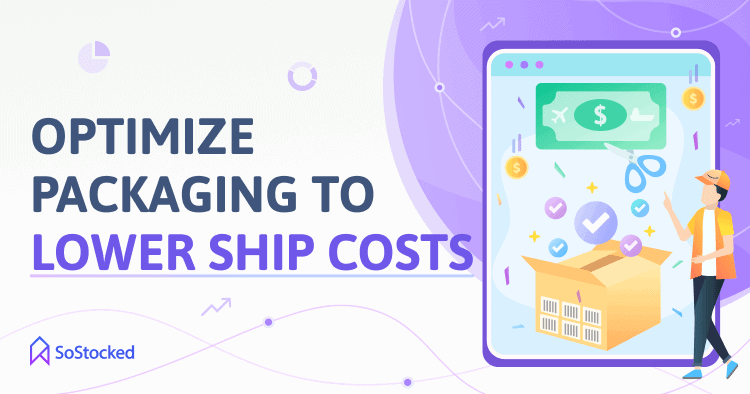
Assess Your Packaging
If your carrier is charging oversize fees, it’s time to rethink your packaging.
How are you packaging your items to be shipped? What are you packing them in? It’s best to keep your
packaging compact, avoid excessive use of inner packaging materials, such as bubble wrap or foam pallets.
Amazon also recommends removing hangers from accessories, bras, hats, shorts, socks, hosiery, sweaters,
swimwear, and underwear, except for blazers, suits, dresses, leather/fur/wool outerwear, and other garments
that cost $299+ each.
Read Amazon's Packaging Requirements for more information.
Perform a Cube Optimization Analysis
Cube optimization is a method for right-sizing your packages. Right-sizing means using only what you need so
you
can fit your product into the smallest packaging dimensions possible without threatening its integrity.
Cube optimization analysis is a study of actual weight versus DIM weight with a goal to minimize OR
eliminate
DIM weight charges in favor of actual weight charges. If you keep getting oversize charges because the cube
size
of your package is greater than the actual weight, you need to figure out better ways to optimize your
boxes.
Pro tip: If you’re paying based on physical weight rather than DIM weight, be aware of heavy
packaging materials that can increase your cargo weight and shipping cost.
Conduct a comprehensive cube analysis to identify improvement areas in your packaging so you can make the
most
of your master cartons or pallets. Optimizing a carton may include thoroughly examining your packaging
materials
to reduce box dimensions and weight so that you can fit more units per carton or pallet. This method also
helps
you identify heavy packaging materials that should be replaced with lighter, recyclable ones.
By optimizing your cartons, you’ll be able to:
- Increase the number of units you can ship per carton, pallet, or FCL/FTL container. This allows you to
ship in bulk and less frequently, thereby reducing your freight costs. Shipping in bulk is often less
expensive than shipping the same volume of inventory in multiple, smaller consignments. Bulk customers
also get lower rates because carriers can load a container more efficiently, i.e., less time and effort
is required as the carrier doesn’t need to process and handle various shipments from various customers.
- Increased warehouse shelving capacity, which means you’ll be able to fit more SKUs within less storage
space, saving on storage cost.
- Properly manage variables, such as carton size and compression strength, stacking strength, and
stability,
enabling better protection against the rigors of transport. Using cartons with excellent crush
resistance is
key to avoiding inventory shrinkage due to damage. When inventory arrives in unsellable condition, it
basically decreases your ability to earn more money. So, you should never cheap out on cartons as a cost
reduction move.
- Billable weight may drop by 1 lb or more due to less packaging materials.
- Reduce or eliminate the use of dunnage (bubble wraps or shredded paper), cardboard fillers, or void
fills
and
introduce sustainability to
your packaging
instead.
- Achieving the smallest DIM weight possible may result in lower shipping costs.
Sort Your Packaging Costs Based on the Durability of Goods
Not all of your products require maximum packaging budget and attention. Some products are naturally more
durable and thus need less packaging materials, while others will require over-boxing (e.g., placing a
packaged
product in a double-wall corrugated box for added protection) or lots of inner packaging materials due to
safety
concerns.
To plan your logistics budget wisely, consider dividing your products into the following packaging
categories:
Fragile
Use multi-layered corrugated boxes with a considerable amount of internal packaging materials and protective
covers (for pallets) to keep your fragile products secured during transport. Benchmark: 3% to 7% of product
cost
for packaging.
Complex
These are the products that need complex packaging because they’re oddly-shaped, extremely heavy, or they
contain sensitive or calibrated components like household appliances, electronics, and musical instruments.
Therefore, they usually require custom-made and highly durable boxes. Benchmark: 8 to 10% of product cost
for
packaging.
Review Your 3PL Warehouse Labor Charges
Ask your 3PL whether their labor charges are broken down into increments of time or if they roll up to 1
hour
minimums. Let’s say your 3PL charges you $40 per hour. If it only takes them 15 minutes to process a
shipment
out of their warehouse, are they charging you in 15 minute increments (e.g., $10 per 15 min) or will you pay
the
whole $40 for that 15 minutes of time?
How warehouse labor is charged at your 3PL makes a huge difference in your total processing fees.
If you have 6 cartons shipped out and it takes 15 minutes to handle those, you could either be paying $10
for
that 15-minute labor which would be $1.67 per carton or $40 which would be $6.67 per carton.
For 6-unit cartons that is either $0.28/unit or $1.11/unit. You can see how these labor fees can quickly
start
to add up to overspending if you don’t know how your 3PL charges you.
Keep An Eye on Your Shipments With SoStocked
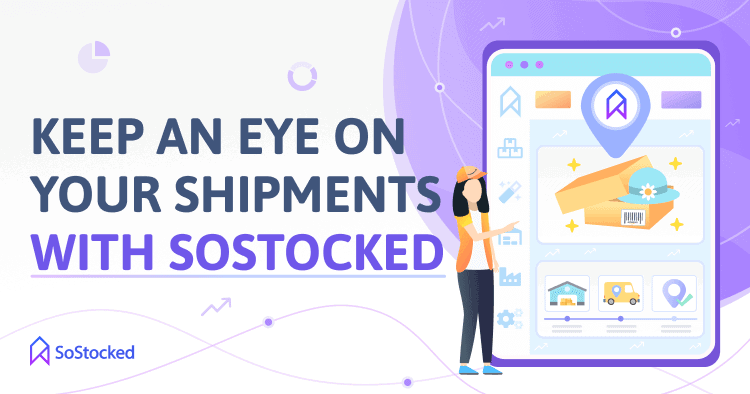
Track your shipment’s movements, from the moment you place a purchase order to in-production to in-transit to
arrival at its final destination using the following SoStocked software features:
Purchase Order (PO) System with Lead Times
Streamline your order and transfer processes with a system that lets you generate purchase orders and assign
lead times to each of your POs.
SoStocked has a built-in PO system for new inventory orders from your
suppliers. You can also use our PO
system
in tandem with our secondary order management system called Work Orders (WO).
Our WO system allows you to set transfer times for processing and shipping goods from your 3PL warehouse or
prep
center to FBA. Assigning lead times to your POs or WOs also makes tracking your shipments within SoStocked
easier.
Order Tracker
Track the progress of
your new inventory orders, from in-production to shipping to final
destination. This tool uses a well-organized Kanban board that automatically moves orders and shipments from
In Production to En Route to 3PL warehouse/FBA based on your assigned lead times.
Inventory Tracking Dashboards
Our Inventory Tracking dashboards are especially useful in tracking in-transit shipments and monitoring
inventory on-hand levels at FBA and 3PL.
- Use the Inbound Shipments dashboard to
determine what POs/WOs are in production and where they are going, whether 3PL or FBA.
- Or, go to our Inventory On-Hand
Dashboards to get a full picture of your inventory across all marketplaces and warehouses,
including all of your on-order and en-route inventory and available stock at FBA FCs and 3PL warehouses,
as well as reserved inventory
Split a Shipment
Split
a shipment within the same PO to be able to send inventory to two or more different FCs or by
multiple modes of shipping (air, sea, or ground). You may need to split a shipment when your inventory level
at FBA is running low, and you need to send in more stock from 3PL or your supplier’s factor by air express
or Small Parcel Delivery (SPD) versus LTL (Less Than Truckload) to prevent a stockout. Instead of creating
two separate POs or WOs, simply use this tool to split your shipment within the same PO or WO. Then, send a
portion of your inventory by one shipping method (e.g., air for rush shipping) and the rest by another
(e.g., ocean).
Optimize Your Packaging To Lower Shipping Costs

In sum, shipping costs are all about space – the more units you can fit into a single master carton, the more
you can ship and sell on Amazon without overspending on transportation costs.
Choose the right master carton to match the size and fragility/durability of your products. The right
packaging
materials can help to lower shipping costs, whether you’re shipping from 3PL or supplier by LTL/FTL, rail,
ocean, or air freight.
For added protection, use the right amount of bubble wrap, poly bags, partition pads, or foam pallets and
avoid
packaging your products in a way that makes them bulky or oddly shaped.
Lastly, use our Master Carton Calculator to figure out how many units you can fit in a master case and
how much
it would cost you to ship them. And utilize SoStocked to track your shipments as they move
through the supply
chain.
If you need more expert advice, talk to your 3PL, FF, or packaging engineer (an engineer that designs and
develops effective packaging solutions for various products). They may be able to help you determine the
best
way to resize your packaging so that you can get as many units into your master cartons as possible,
eliminating
the need to buy more pallets.
Get Started
1,000+ Customers. Free Data Migration. 1-on-1 Onboarding.
Need more information?
-
Send Message: We typically reply within 2
hours during office hours.
-
Schedule Demo: Dive
deeper into the nuances of our
software with Chelsea.
-
Join Live Upcoming
Webinar: New to Amazon inventory
management? Learn three inventory techniques you can implement right away.
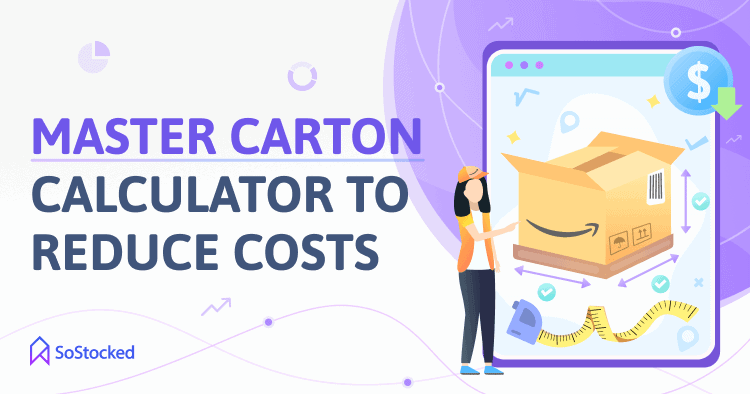
 Get Started
Get Started

 Watch the Video
Watch the Video






